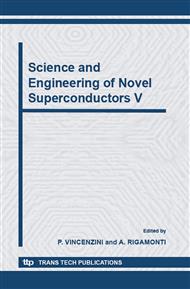p.43
p.49
p.55
p.63
p.69
p.75
p.82
p.88
p.93
Interband Pairing Interaction in Magnesium Diboride Probed by Tunneling Spectroscopy
Abstract:
We report on the study of the interband pairing interaction in the two-band superconductor MgB2 by tunneling spectroscopy using thin film tunnel junctions. The films were deposited in situ by an approach comprising a conventional planar B sputter gun and a special homemade Mg evaporator providing a high vapor pressure. For the tunneling experiments sandwich-type crossed-strip tunnel junctions with a native MgB2 oxide as the potential barrier and Al, In or Pb counterelectrodes were prepared. Voltage-dependent differential conductance measurements revealed estimates of the barrier thickness and height of 1.5 nm and 1.6 eV, respectively, and allowed us to determine the phonon-induced structures in the tunneling density of states of the phonon-mediated superconductor MgB2. The analysis of the reduced density of states using the standard single-band Eliashberg equations yielded an effective electron-phonon spectral function accounting for the smaller energy gap. A further analysis involving ab-initio LDA calculations and the two-band Eliashberg equations revealed that the dominant feature in the effective spectral function, a strong peak at 58 meV, was mainly due to the interband pairing interaction.
Info:
Periodical:
Pages:
69-74
Citation:
Online since:
October 2006
Keywords:
Price:
Сopyright:
© 2006 Trans Tech Publications Ltd. All Rights Reserved
Share:
Citation:


